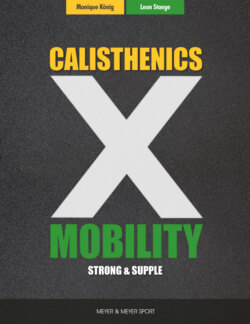Читать книгу Calisthenics X Mobility - Monique König - Страница 20
На сайте Литреса книга снята с продажи.
2.4 WHY STRETCHING AND YOGA WON’T MAKE YOU MORE MOBILE
ОглавлениеBut, Leon, what about the muscles? Don’t they have to be stretched and mobilized to be more flexible?
Ultimately, your muscles are simply the executing organs of your nervous system’s signals.
It’s the job of your muscles to move your joints and protect them. Flexibility happens in the joints. OK, but my muscles are tight!
Right. So let me explain.
The purpose of all mobility exercises is to move your joints into an “unfamiliar” position and to learn to control it via muscle tension. When you learn to control your joint position, your nervous system registers this input and responds (output) by releasing your muscles, with efficient tension, at their current length.
This means your muscles no longer resist this joint position–resolving what we know as tight muscles. The more you practice this joint position, the better your body is able to release this muscle length faster and with more strength. You’ll become stronger at this range of motion and able to move without restrictions.
Muscles are always given obtuse orders on how to behave. But if you want to achieve long-term changes, you must talk to the messengers (joints) and the commander (brain). If you focus only on your muscles during mobility training, meaning you only try to passively lengthen (stretch) your muscles, the communication between messengers and commander is insufficient. After all, your brain wants specific information about what needs to be done.
In physical therapy, we always talk about how training should be movement specific. This is true for strength training as well as mobility training. Regardless of which sport you’re preparing for with mobility training or wanting to improve your performance of through better mobility, one thing is certain: strength is always a factor, even if it’s gravity that makes it necessary for you to become strong in your mobility.
Lengthening your muscles will, at best, have a very short-term effect that won’t be optimally wired in your nervous system. Always think about the input your brain receives, processes, and subsequently creates as output. When your input (e.g., stretches that were held too long) doesn’t match the requested output (e.g., a pull-up) you won’t benefit from the briefly acquired range of motion.
Lots of yogis have participated in our past Calisthenics X Mobility workshops. Most of them were a bit surprised when I insisted that passive stretching is a waste of time when you’re trying to become more mobile. Most of them reported that their usually statically held positions had resulted in increased range of motion.
The explanation is simple: if you practice something often, you’ll get better.
For instance, if I practice doing the splits often and long enough, I’ll, at some point, master them. Remember, communication with the brain is the decisive factor for long-term adaptations.
Passive stretching and static yoga poses don’t provide nearly as much information for the brain as movement does.
When you’re moving, you have to concentrate more, the impact on your vestibular system is significantly higher, and your mechanoreceptors (sensory receptors in joints, muscles, tendons, ligaments, and the skin that perceive mechanical loading) receive more input.
These and other factors result in the body adapting more quickly to a certain movement or range of motion. But don’t get me wrong, I’m not opposed to yoga. This is purely about the differentiation between passive and active flexibility. There are many other reasons why people do yoga, but, in general, I find that yoga doesn’t make us as efficiently mobile as structured mobility training does.
